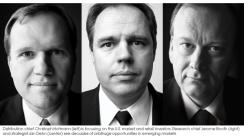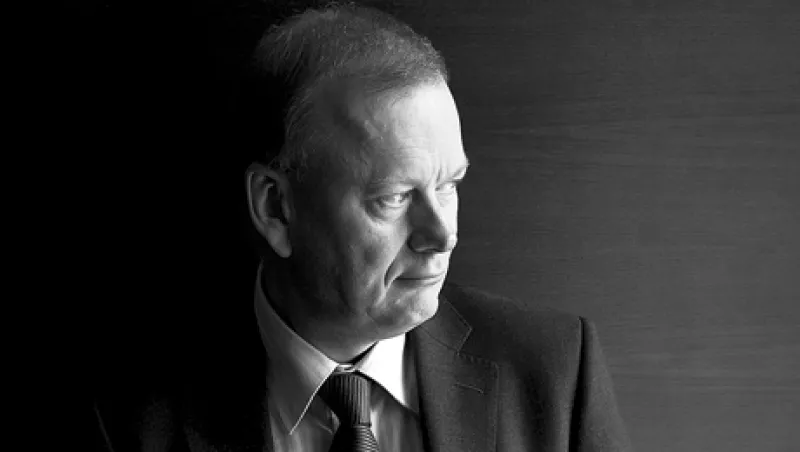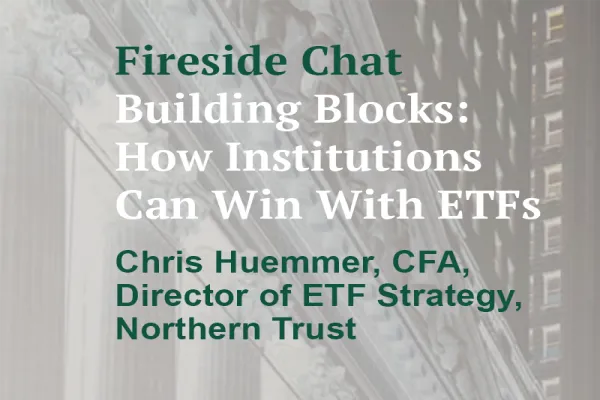AFTER WEEKS OF MOUNTING TENSIONS IN FINANCIAL MARKETS, European Union leaders gathered in late June for what was billed as a make-or-break summit. Greek voters had given tepid support to their government’s austerity program, yields on Italian and Spanish bonds were approaching unsustainable levels, and many analysts predicted the euro would collapse without decisive action. To the surprise of many investors, EU leaders exceeded expectations and agreed on a package of measures — including the outlines of a collective banking union — designed to contain the bloc’s debt crisis. European stocks and bonds rallied sharply.
Count Jerome Booth as unimpressed.
“Nothing has really changed,” says the economist and head of research at London-based Ashmore Investment Management. Greece remains insolvent, and problems are worsening in other parts of the euro area, he contends. In fact, he argues, Europe and the U.S. are the main sources of risk in today’s global economy and face years of slow growth and painful restructuring to reduce their debts and regain competitiveness. Emerging markets, already half of the world economy on a purchasing power basis, are driving global growth, and investors should place more of their money there, Booth adds.
That view of emerging markets has moved from the fringes of investment thinking to something approaching a consensus in recent years, and few have contributed to that change — and profited from it — as much as Ashmore. The emerging-markets debt specialist firm had just $500 million in assets when it was established 13 years ago, in the wake of Russia’s debt default, in a management buyout led by Booth, founder Mark Coombs and five other partners. With Coombs, 52, overseeing money management and Booth, 49, serving as globe-trotting proselytizer-in-chief, the firm has delivered impressive performance and extolled the benefits of emerging markets to clients ranging from the Pennsylvania State Employees’ Retirement System to sovereign wealth funds and central banks.

Today, Ashmore manages $65.9 billion (as of the end of March) in emerging-markets assets across a range of classes, including dollar-denominated and local currency sovereign bonds, corporate debt, equities and alternatives. Parent company Ashmore Group went public just six years ago and is a constituent of the FTSE 100 Index, with a market capitalization of £2.4 billion ($3.8 billion). As notable as that growth is, the firm’s top executives believe they’ve just scratched the surface.
“We’ll be offering investors a full-service emerging-markets investment management proposition,” says Coombs, Ashmore’s controlling shareholder. In five years’ time, he adds, “it would be surprising if we weren’t over $100 billion. And there’s a chance we obviously could be a lot bigger than that.”
There certainly is, if investor demand continues at its recent pace. Funds dedicated to emerging-markets debt attracted inflows of $847 million, or 0.6 percent of the sector’s overall assets, in the week ended July 5 — $15.1 billion since the start of the year, according to data provider EPFR Global. Yet most institutions still have very little emerging-markets debt in their portfolios. A recent survey by J.P. Morgan found that U.S. insurance companies held an average of just 3 percent of their assets in emerging-markets debt.
“That tells me they’re 47 percent underweight,” says Booth. “These markets are going to expand enormously.” Emerging-markets fixed-income products are currently worth $12 trillion, out of a global fixed-income market of some $80 trillion. Booth predicts the emerging-markets segment will nearly quadruple in size, to $47 trillion, by the end of this decade. If investors increased their overall emerging-markets allocations, including debt and equity, by just 1 percentage point, that would generate inflows of more than $500 billion, he estimates.
To take advantage of that rapidly expanding universe, Ashmore has been on a growth tear of its own. The firm has increased its staff eightfold since 2005, when it managed about $8 billion, to some 250 people, including 90 investment professionals. Although most of the growth has been organic, the group added an equity capability last year when it acquired Emerging Markets Management, an Arlington, Virginia–based outfit founded by Antoine van Agtmael, the onetime World Bank executive who coined the term “emerging markets.” The renamed Ashmore EMM manages slightly less than $8 billion in equities.
Ashmore has also overhauled its investment process from one directed almost single-handedly by Coombs — who got his start in the 1980s by trading illiquid pieces of Latin American bank debt — to a team-oriented approach. Virtually every position taken is discussed at the group’s Monday morning investment committee meeting, and none of Ashmore’s 130-odd funds across eight broad themes has a single portfolio manager. It’s the antithesis of a star culture. “We’ve successfully reduced key-man risk,” says Booth.
To fuel its growth, Ashmore is looking to expand beyond its core institutional clientele. The firm offers a suite of mutual funds in Europe, the U.S. and Japan. More innovatively, the group has established fund management subsidiaries in Turkey and Brazil in the past few years. Although these “mini-Ashmores” are still a tiny part of the group, Coombs wants to develop them in markets such as China, India and South Korea to manage emerging-markets assets on behalf of clients in those regions. This would put the firm in the middle of the so-called South-South capital flows among emerging markets.
Many analysts are optimistic that Ashmore can keep up the strong growth record. “They’ve managed to position themselves as having a very clear, positive vision on emerging markets,” says Igor Arsenin, head of Latin America strategy at Credit Suisse in New York. “That’s where the demographics are; that’s where the growth is.”
Yet Ashmore faces plenty of challenges as it seeks to fulfill its leaders’ ambitions.
For one thing, the competition is intensifying. What was exotic, unplowed territory in the late ’90s is now one of the most hotly contested areas of investment management. Virtually every fund manager is looking to grow its emerging-markets business, whether it’s a boutique like Stone Harbor Investment Partners, a New York–based emerging-markets debt specialist founded six years ago by a group of former Citigroup Asset Management executives, or a giant like Pacific Investment Management Co., the $1.77 trillion-in-assets behemoth whose CEO and co-CIO, Mohamed El-Erian, is also a big emerging-markets advocate.
“Virtually every real money house out there is looking to hire an EM debt team,” says Rashique Rahman, head of emerging-markets macro strategy at Morgan Stanley in New York. “There’s a reason for that. That’s where the money is going.”
But the environment for emerging markets is less favorable today than it has been in recent years. Europe’s debt crisis has sent shock waves around the world, putting the U.S. economy in danger of stalling and slowing markets from Asia to Latin America. In recognition of the danger, the People’s Bank of China in early July cut its key short-term interest rate for the second time in a month, to 6.0 percent from 6.31 percent.
The slowdown raises the risk of financial instability in emerging markets. Although their fundamentals remain stronger than those of most developed economies, many developing countries have relied on debt to fuel a good part of their recent growth. “The fraction of GDP that households and firms in Brazil, China, India and Turkey are allocating to debt service stands at its highest level since the late 1990s, or close to it,” the Bank for International Settlements cautioned at the end of June.
Booth acknowledges the headwinds, but he insists that most emerging markets can surmount them. China has used everything from infrastructure spending to interest rate cuts to keep its economy powering along, and investors would be foolish to bet against Beijing now, he says. Banco Central do Brasil has cut rates aggressively over the past year, yet its key short-term rate, the Selic, still stands at 8.5 percent, far from the zero bound that vexes the Federal Reserve Board and the European Central Bank. Emerging markets have unprecedented foreign exchange reserves — some $7 trillion — to cushion a global downturn. Western policymakers would love to have such tools at their disposal.
“The level of policy response options is enormous,” says Booth. “The problems are minor compared with the high-income countries. In no way can we say the basic strengths of emerging markets have changed.”
As for the competition, Booth is relaxed. Yes, other players are crowding Ashmore’s turf, but the size and sophistication of capital markets in emerging economies are growing tremendously. “There’s plenty to go around,” he says. “This is not a zero-sum game.”
For many at Ashmore, emerging-markets investing is more than just a business specialty — it is almost a religion. This passion for developing economies dates back to childhood in many cases.
Felicia Morrow, CEO of Ashmore EMM, recalls leaving her Santa Monica, California, home as a child to spend summers with her grandparents on the Mexican border. She went on to study economics and anthropology at Stanford University, then spent two years in the early 1970s in Indonesia as a volunteer, teaching English. “You wouldn’t recognize the place now,” she says. “Indonesia appears to be at a turning point and has got its house in order. There’s lots of investment in infrastructure. There’s lots of foreign investment going in. It’s just got so much going for it.”
Jan Dehn, Ashmore’s London-based head of strategy, spent his junior and senior high school years in Tanzania and Kenya, where his parents worked for the Danish equivalent of the Peace Corps. He earned a Ph.D. in economics from the University of Oxford, where his adviser was celebrated development economist Paul Collier. Dehn, who spent two years in the mid-’90s working as an adviser to the Uganda Finance Ministry, believes the end of the Cold War transformed the potential of emerging markets, forcing countries to implement reforms that attract private capital rather than playing the U.S. and Soviet Union against each other for benefits. “Aid has been part of my life, and I’ve seen it doesn’t work,” Dehn says.
MARK LANGHORN COOMBS DEVELOPED HIS PASSION for emerging markets largely on the job. He did some traveling in his youth and studied geography and law at the University of Cambridge, graduating with a BA in 1983 before heading to the City of London, which at that time was gearing up for a generation-long financial boom. He took a job at Grindlays Bank because of its heavy international accent and went to work on the Latin America desk.
The region’s debt crisis had erupted the year before when Mexico announced it couldn’t service its debts and banks suddenly found themselves holding billions of dollars worth of dubious and illiquid loans. Looking to make money on Grindlays’ loan book, Coombs and his colleagues in 1985 started swapping some Latin assets with other banks. Gradually, the desk started brokering transactions for other banks, ultimately investing some of Grindlays’ own capital in debt trading. The bank, which was acquired by Australia and New Zealand Banking Group in 1984 and later renamed ANZ Grindlays Bank, was well positioned in 1989 when then–U.S. Treasury Secretary Nicholas Brady kick-started a vibrant secondary market by allowing countries to exchange their debt for tradable bonds.
Sensing a larger opportunity, Coombs persuaded his bosses to expand beyond the interbank market and manage outside money. In October 1992 he launched the Emerging Markets Liquid Investment Portfolio with $18 million — “that felt like a huge amount of money at the time,” he says — raised mostly from wealthy Middle Eastern clients. The fund aimed to produce relatively high returns with a conservative strategy of investing in a diverse pool of liquid emerging-markets securities, mostly sovereign debt.
That strategy paid off three years later. Markets were in turmoil after a massive spike in U.S. Treasury yields in 1994 and Mexico’s financial crisis at the end of that year, but when the Liquid Investment Portfolio unveiled its three-year track record in 1995, it boasted annualized returns of 23.2 percent, nearly 10 percentage points better than J.P. Morgan’s Emerging Markets Bond Index Global Diversified. “Our intention was to be very conservative, but, lo and behold, we had the best-performing fund,” says Booth.
That performance attracted strong inflows, but ANZ decided to pull back from emerging markets in 1998, in the wake of the Asian financial crisis and Russia’s debt default.
So Coombs and six partners took the fund management business private in a 1999 management buyout, terms of which were not disclosed. It would be by far their best investment. At a time when most investors had fled emerging markets and were focusing on the technology boom, Coombs and his team were doubling down on the sector, convinced of the long-term potential. “We didn’t feel like we were taking a big risk,” says Booth. “We had assets at a very low price. Our funds did very well.”
Ashmore went public in a 2006 IPO, and its strong performance allowed the group to enter the FTSE 100 Index in September 2011. In early July, Coombs’s 41.75 percent stake was worth £1 billion based on the company’s share price of 344 pence. Forbes estimates his net worth at $2.4 billion, making him the 16th-richest person in the U.K. Booth, the only co-founder besides Coombs who is still active in the firm, owns a 6.7 percent stake worth £163 million. Other notable shareholders include Boston-based Fidelity Investments, with a 4.98 percent stake, and BlackRock, with 4.41 percent.
Coombs is an unusual chief executive for a public concern. He almost single-handedly created one of the U.K.’s fastest-growing companies with his vision and drive, yet he shuns the limelight. An intensely private man, Coombs hadn’t given an interview to any publication since Ashmore went public before speaking with Institutional Investor for this article — by telephone.
Jon Moulton, a venture capitalist who was the only outside investor in the management buyout, recalls why he decided to back Coombs: “He was determined, bright, absolutely single-minded. I liked him. It was a good call.” That’s an understatement. Moulton invested £250,000 in the buyout, for slightly less than 7.5 percent of the firm. The IPO valued his stake at £89 million. He has since sold most of his holding, but he retains a small interest for reasons of “good investment and affection.”
In 1994, Booth was working as an economist at the Inter-American Development Bank in Washington, hoping to return to London. He had lined up interviews with eight banks, but after talking with Coombs for 40 minutes, Booth accepted a job offer and cut short his search. “It was obvious that this guy was going to be successful,” he says of Coombs. “He’s a gentleman. He has character. I can trust him. If he says he’s going to do something, he’s going to do it. If he agrees to something, he will stick with it forever.” Today, Booth — who plays double bass in amateur orchestras in his spare time — is Coombs’s public alter ego, meeting frequently with investors and promoting Ashmore’s views with investment notes and appearances on CNBC and other media outlets.
Coombs continues to put his own stamp on Ashmore’s culture, even while surrendering portfolio management in favor of a team-based approach. In Moulton’s view, the successful transition from a firm very much centered around Coombs — “an efficient, well-run dictatorship,” as he puts it — to an organization that takes decisions collectively makes Ashmore “a singularity.”
Ashmore pays relatively modest base salaries — Coombs and finance director Graeme Dell earn £100,000 a year — while offering sizable performance-related bonuses that vest over five years. Strategist Dehn says the staff loves the long-term focus. “We all to a tee buy in to this,” he says. “I’m never leaving this firm.”
Although he has loosened his control and gradually sold off nearly 20 percent of the company over the past six years, Coombs insists he has no plans to retire any time soon. “You’ve got to want to try and make a difference every day and perform,” he says. “It gives me a buzz. I can’t see any reason I would stop doing it.”
Coombs’s investment philosophy is simple. In a nutshell: Retain faith in the emerging-markets story, buy when others are selling, and stay as liquid as possible.
“We try not to be doing things at the same time as everybody else,” says Coombs. “Our approach has often been to acquire risk in crisis, to do it very steadily and progressively, and to be disciplined about it on the basis that over a three-year cycle you’re going to be a huge outperformer. If you take short-term negative mark-to-market to achieve that, that’s okay.” The firm did well by buying assets early in the first quarter of 2009, before the rebound in financial markets took hold, says Booth.
Ashmore has cultivated relationships with policymakers in emerging markets, both to inform its own investment decisions and to win business. Central banks, sovereign wealth funds and other governmental bodies constituted 31 percent of the group’s investor base at the end of June 2011 (the most recent figure available). Booth is a frequent visitor to Beijing; the firm’s patient efforts to nurture relationships in China paid off in 2007 when the government allowed Ashmore to take a 19.99 percent stake in Beijing Investment Trust Co., a securities and fund management company.
The company’s formula has certainly delivered. Ashmore’s broad external debt composite, which covers a variety of segregated accounts and mutual funds — including the Liquid Investment Portfolio — that invest primarily in dollar-denominated sovereign debt, has generated an annualized return of 20.26 percent since inception in 1992, compared with 11.89 percent for J.P. Morgan’s EMBI GD. The firm’s local currency bonds composite has produced annualized returns of 11.38 percent since inception in August 2005, compared with 10.9 percent for J.P. Morgan’s Government Bond Index–EM Global Diversified. Ashmore’s corporate debt broad composite has produced returns of 12.83 percent since inception in August 2007, compared with 7.65 percent for J.P. Morgan’s Corporate Emerging Market Bond Index Broad Diversified.
The business has also delivered for shareholders. Ashmore’s net income was flat in the first half of its financial year, which ended on December 31, at £96.1 million, as weak markets during the period contributed to a 61.7 percent drop in performance fees, to £23 million. The firm’s net management fee margin of 76 basis points of assets under management is well above the industry average, though.
At the end of March, Ashmore managed $15.1 billion in external debt, $10.3 billion in local currency debt, $2.3 billion in corporate debt, $12.3 billion in blended debt, $7.8 billion in equities, $2.7 billion in alternatives (including Chinese and Russian real estate joint ventures and an Indian special-situations fund), $6.5 billion in multistrategy accounts and $8.9 billion in overlay and liquidity products.
Ashmore’s foray into equities underscores the risk and volatility that persist in emerging markets despite the countries’ growing economic clout. Equity arm EMM rode the boom as well as anyone in the past decade, growing assets to a peak of more than $20 billion in 2007. But the firm made some bad calls, notably by being underweight on China in 2006 and ’07 because of concerns over the health of Chinese banks, then by hesitating to take on risk in early 2009, when emerging markets led a global rebound. Poor performance sent many clients packing, and assets plunged by 50 percent in 2008 alone.
Morrow says the firm learned a painful lesson: Don’t let macro sentiment cloud your bottom-up stock selection. “It’s really important to focus on valuations and fundamentals,” she says. “We don’t know what’s going to happen in the world, but where a quality management is in charge, we can take some comfort.” For his part, Coombs believes EMM’s investment process is sound, and he likes the firm’s team-oriented culture. Ashmore’s $246 million purchase helped grease the exit for van Agtmael, who’s retiring, and provide equity incentives to retain EMM’s 39 portfolio managers.
With a full array of emerging-markets investment products, Ashmore is ramping up its sales efforts. The U.S. is a key target, says Christoph Hofmann, who joined two years ago from Pimco as global head of distribution. Currently, some 80-odd U.S. clients contribute 22 percent of the group’s assets. “We certainly want to maintain that or even grow it,” says Hofmann.
Ashmore is also making a play for affluent retail investors. In the past two years, the firm has launched a range of mutual funds, which it sells through the likes of Barclays and UBS in Europe, Charles Schwab Corp. and Fidelity in the U.S., and SMBC Nikko Securities in Japan. “We don’t want your cousin to know about Ashmore,” Hofmann says. “We want your cousin’s private banker to know about Ashmore.” Retail now makes up 16 percent of Ashmore’s investor base, but the firm aims to grow that share to as much as 45 percent within five years, says finance director Dell.
The really interesting target, however, is the emerging markets themselves. For the better part of 20 years, Ashmore’s sales pitch has been that these developing nations will dominate the 21st-century economy. If it wants to ensure its own future, the firm needs to manage a chunk of that growing wealth.
Ashmore begins with a solid base. At the end of December, $13.2 billion of its assets originated in emerging markets, much of it from central banks and sovereign wealth funds. In addition, the firm opened subsidiaries in Brazil in 2007 and in Turkey in 2008 to manage money locally for local clients; those units had $300 million and $150 million, respectively, in assets at the end of March. That’s pretty small beer. Franklin Templeton Investments, which is pursuing a similar strategy, has built up nearly $2 billion in assets in Malaysia alone.
Executives say Ashmore will launch more local subsidiaries in the next five years, with the most likely targets including China, Colombia, India and South Korea.
It adds up to an ambitious agenda. The only question is, can emerging markets — and Ashmore — deliver on their promises?
Booth, for one, has no doubts. He is confident that emerging markets will grow until they offer every asset class that exists in the U.S. He’s already thinking of a core-plus product, but with a twist: It would invest 80 to 85 percent of assets in emerging markets and tactically place the remaining 15 to 20 percent in now-risky developed markets. “You’re talking about 30 years of arbitrage possibilities,” he says. • •






